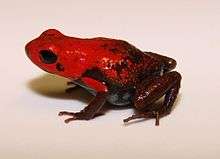Andinobates virolinensis
Andinobates virolinensis (the Santander poison frog) is a species of frog in the family Dendrobatidae. It is endemic to Colombia where it is confined to the Santander and Cundinamarca departments on the Cordillera Oriental.[2][3]
| Santander poison frog | |
|---|---|
 | |
| Scientific classification | |
| Kingdom: | Animalia |
| Phylum: | Chordata |
| Class: | Amphibia |
| Order: | Anura |
| Family: | Dendrobatidae |
| Genus: | Andinobates |
| Species: | A. virolinensis |
| Binomial name | |
| Andinobates virolinensis (Ruíz-Carranza & Ramírez-Pinilla, 1992) | |
| Synonyms | |
|
Minyobates virolinensis Ruiz-Carranza and Ramírez-Pinilla, 1992 | |
Description
Andinobates virolinensis are small frogs, measuring up to 19 mm (0.75 in) in snout–vent length.[4]
Habitat, life cycle, and diet
Andinobates virolinensis live on the floor of cloud forest. Females lay the eggs in leaf-litter, and the males bring the larvae to the bromeliads.[1] Reproduction occurs throughout the year.[5] The diet consists of various arthropods, including mites, springtails, ants, and insect larvae. Thus, their diet is broadly similar to other poison dart frogs.[4]
Conservation
Andinobates virolinensis is considered "Vulnerable" by IUCN because it is known from very few locations and because its habitat is threatened by habitat loss, primarily due to agricultural expansion. However, where it occurs it is a common species.[1]
Andinobates virolinensis is sometimes found in pet trade, despite the Decree INDERENA No. 39 from July 1985 that forbade the collection of dendrobatids from the wild for breeding (or other) purposes.[1]
References
- IUCN SSC Amphibian Specialist Group. 2017. Andinobates virolinensis. The IUCN Red List of Threatened Species 2017: e.T55211A85886160. https://dx.doi.org/10.2305/IUCN.UK.2017-3.RLTS.T55211A85886160.en. Downloaded on 3 January 2019.
- Frost, Darrel R. (2015). "Andinobates virolinensis (Ruiz-Carranza and Ramírez-Pinilla, 1992)". Amphibian Species of the World: an Online Reference. Version 6.0. American Museum of Natural History. Retrieved 16 April 2015.
- Acosta-Galvis, A.R. (2014). "Andinobates virolinensis (Ruiz & Ramírez, 1992)". Lista de los Anfibios de Colombia V.05.2015.0. batrachia.com. Archived from the original on 16 April 2015. Retrieved 16 April 2015.
- Valderrama-Vernaza, M.; Ramírez-Pinilla, M. P.; Serrano-Cardozo, V. C. H. (2009). "Diet of the Andean frog Ranitomeya virolinensis (Athesphatanura: Dendrobatidae)". Journal of Herpetology. 43: 114–123. doi:10.1670/07-247R1.1.
- Valderrama-Vernaza, M.; Serrano-Cardozo, V. C. H.; Ramírez-Pinilla, M. P. (2010). "Reproductive activity of the Andean frog Ranitomeya virolinensis (Anura: Dendrobatidae)". Copeia. 2010 (2): 211–217. doi:10.1643/CE-09-161.
